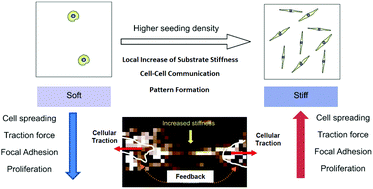当前位置:
X-MOL 学术
›
Biomater. Sci.
›
论文详情
Our official English website, www.x-mol.net, welcomes your
feedback! (Note: you will need to create a separate account there.)
Cell density overrides the effect of substrate stiffness on human mesenchymal stem cells' morphology and proliferation.
Biomaterials Science ( IF 5.8 ) Pub Date : 2018-03-12 00:00:00 , DOI: 10.1039/c7bm00853h Balu Venugopal 1 , Pankaj Mogha , Jyotsna Dhawan , Abhijit Majumder
Biomaterials Science ( IF 5.8 ) Pub Date : 2018-03-12 00:00:00 , DOI: 10.1039/c7bm00853h Balu Venugopal 1 , Pankaj Mogha , Jyotsna Dhawan , Abhijit Majumder
Affiliation

|
The effect of substrate stiffness on the cellular morphology, proliferation, and differentiation of human mesenchymal stem cells (hMSCs) has been extensively researched and well established. However, the majority of these studies are done with a low seeding density where cell to cell interactions do not play a significant role. While these conditions permit an analysis of cell–substratum interactions at the single cell level, such a model system fails to capture a critical aspect of the cellular micro-environment in vivo, i.e. the cell–cell interaction via matrix deformation (i.e., strain). To address this question, we seeded hMSCs on soft poly-acrylamide (PAA) gels, at a seeding density that permits cells to be mechanically interacting via the underlying substrate. We found that as the intercellular distance decreases with the increasing seeding density, cellular sensitivity towards the substrate rigidity becomes significantly diminished. With the increasing seeding density, the cell spread area increased on a soft substrate (500 Pa) but reduced on an even slightly stiffer substrate (2 kPa) as well as on glass making them indistinguishable at a high seeding density. Not only in terms of cell spread area but also at a high seeding density, cells formed mature focal adhesions and prominent stress fibres on a soft substrate similar to that of the cells being cultured on a stiff substrate. The decreased intercellular distance also influenced the proliferation rate of the cells: higher seeding density on the soft substrate showed cell cycle progression similar to that of the cells on glass substrates. In summary, this paper demonstrates how the effect of substrate rigidity on the cell morphology and fate is a function of inter-cellular distance when seeded on a soft substrate. Our AFM data suggest that such changes happen due to local strain stiffening of the soft PAA gel, an effect that has been rarely reported in the literature so far.
中文翻译:

细胞密度超越了基质硬度对人间充质干细胞形态和增殖的影响。
基质硬度对人间充质干细胞 (hMSC) 细胞形态、增殖和分化的影响已得到广泛研究并得到充分证实。然而,大多数这些研究都是在低接种密度下进行的,其中细胞与细胞的相互作用不起重要作用。虽然这些条件允许在单细胞水平上分析细胞-基质相互作用,但这样的模型系统无法捕获体内细胞微环境的一个关键方面,即通过基质变形(即应变)进行的细胞-细胞相互作用。 。为了解决这个问题,我们将 hMSC 接种在软聚丙烯酰胺 (PAA) 凝胶上,接种密度允许细胞通过底层基质进行机械相互作用。我们发现,随着细胞间距随着接种密度的增加而减小,细胞对基质刚性的敏感性显着降低。随着接种密度的增加,细胞铺展面积在软基质 (500 Pa) 上增加,但在稍硬的基质 (2 kPa) 以及玻璃上减少,使得它们在高接种密度下难以区分。不仅在细胞铺展面积方面,而且在高接种密度下,细胞在软基质上形成成熟的粘着斑和突出的应力纤维,类似于在硬基质上培养的细胞。细胞间距离的减小也影响了细胞的增殖率:软基质上较高的接种密度显示细胞周期进程与玻璃基质上的细胞相似。 总之,本文证明了当接种在柔软的基质上时,基质刚性对细胞形态和命运的影响如何是细胞间距离的函数。我们的 AFM 数据表明,这种变化是由于软 PAA 凝胶的局部应变硬化而发生的,迄今为止文献中很少报道这种效应。
更新日期:2018-03-12
中文翻译:

细胞密度超越了基质硬度对人间充质干细胞形态和增殖的影响。
基质硬度对人间充质干细胞 (hMSC) 细胞形态、增殖和分化的影响已得到广泛研究并得到充分证实。然而,大多数这些研究都是在低接种密度下进行的,其中细胞与细胞的相互作用不起重要作用。虽然这些条件允许在单细胞水平上分析细胞-基质相互作用,但这样的模型系统无法捕获体内细胞微环境的一个关键方面,即通过基质变形(即应变)进行的细胞-细胞相互作用。 。为了解决这个问题,我们将 hMSC 接种在软聚丙烯酰胺 (PAA) 凝胶上,接种密度允许细胞通过底层基质进行机械相互作用。我们发现,随着细胞间距随着接种密度的增加而减小,细胞对基质刚性的敏感性显着降低。随着接种密度的增加,细胞铺展面积在软基质 (500 Pa) 上增加,但在稍硬的基质 (2 kPa) 以及玻璃上减少,使得它们在高接种密度下难以区分。不仅在细胞铺展面积方面,而且在高接种密度下,细胞在软基质上形成成熟的粘着斑和突出的应力纤维,类似于在硬基质上培养的细胞。细胞间距离的减小也影响了细胞的增殖率:软基质上较高的接种密度显示细胞周期进程与玻璃基质上的细胞相似。 总之,本文证明了当接种在柔软的基质上时,基质刚性对细胞形态和命运的影响如何是细胞间距离的函数。我们的 AFM 数据表明,这种变化是由于软 PAA 凝胶的局部应变硬化而发生的,迄今为止文献中很少报道这种效应。











































 京公网安备 11010802027423号
京公网安备 11010802027423号